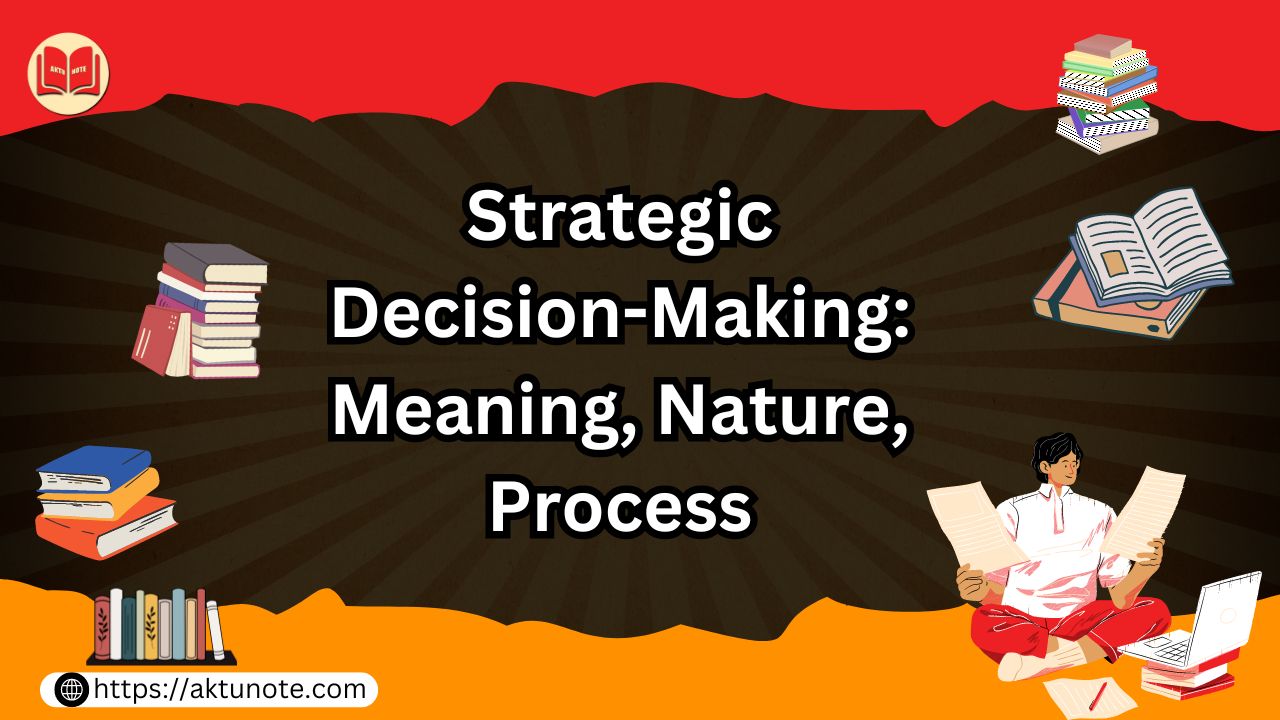Making decisions is part of our daily lives, whether we’re deciding what to eat for dinner or how to manage our finances. But when it comes to organizations, the stakes are a whole lot higher. The strategic decision-making process is all about making choices that will shape the future of a business. It’s not just about picking the best option but about understanding the long-term implications of those choices. Let’s break down what the strategic decision-making process involves and why it’s so crucial for organizations.
Understanding Strategic Decision-Making
Strategic decision-making is a process where leaders in an organization choose the best course of action to achieve long-term goals. Unlike everyday decisions, which might be made quickly and with little thought, strategic decisions require careful analysis and consideration. It’s like deciding to buy a house—there’s a lot to think about, and the decision will have long-lasting consequences.
The strategic decision-making process is a critical element in the management of any organization, shaping its direction and determining its long-term success. This process involves making choices that align with the organization’s goals, considering both internal and external factors, and weighing various alternatives. In a rapidly changing business environment, effective strategic decision-making is essential for maintaining competitive advantage, driving growth, and ensuring sustainability. This article provides a detailed exploration of the strategic decision-making process, emphasizing its importance and outlining the key stages involved.
This process is about more than just reacting to immediate problems. It involves looking at the bigger picture, considering both internal factors (like the organization’s strengths and weaknesses) and external factors (like market trends and competition). The goal is to make decisions that will not only solve today’s issues but also position the organization for future success.
The Nature of Strategic Decision-Making
Strategic decision-making is distinct from operational or tactical decision-making due to its long-term focus, broader impact, and complexity. These decisions often involve significant investments of resources, carry substantial risk, and influence the overall direction of the organization. The nature of strategic decision-making can be characterized by the following features:
Long-Term Orientation
Strategic decisions are forward-looking, with a focus on the future of the organization. They involve setting long-term objectives and determining the best course of action to achieve those goals over an extended period.
Complexity and Uncertainty
Strategic decisions are inherently complex, as they require the consideration of multiple factors, including market trends, competitive dynamics, technological changes, and regulatory environments. The uncertainty associated with these factors adds to the challenge of making strategic decisions.
Interdisciplinary Approach
Strategic decision-making requires input from various disciplines, including finance, marketing, operations, and human resources. This interdisciplinary approach ensures that all aspects of the organization are considered when making strategic choices.
High Impact
The outcomes of strategic decisions can have far-reaching effects on the organization, influencing its competitive position, financial performance, and reputation. These decisions often shape the organization’s identity and determine its long-term success or failure.
Involvement of Top Management
Strategic decision-making is typically the responsibility of top management, as it requires a deep understanding of the organization’s vision, mission, and values. The involvement of top executives ensures that strategic decisions are aligned with the overall direction of the organization.
The Strategic Decision-Making Process
The strategic decision-making process can be broken down into several key stages. Each stage plays a crucial role in ensuring that the decision is well-informed, aligned with the organization’s goals, and capable of driving long-term success. The following sections outline these stages in detail:
Problem Identification and Diagnosis
The first stage of the strategic decision-making process involves identifying and diagnosing the problem or opportunity that requires a decision. This stage is critical for ensuring that the decision-making process is focused on addressing the right issues. The key steps involved in this stage include:
Recognizing the Need for a Decision
The need for a strategic decision may arise from various sources, such as changes in the external environment, internal performance issues, or shifts in market dynamics. Recognizing this need is the first step in the process.
Defining the Problem or Opportunity
Once the need for a decision is recognized, the next step is to clearly define the problem or opportunity. This involves understanding the underlying causes, identifying the key stakeholders involved, and determining the potential impact on the organization.
Gathering Relevant Information
To diagnose the problem accurately, decision-makers must gather relevant information from both internal and external sources. This information provides the foundation for understanding the context of the decision and identifying potential solutions.
Generating and Evaluating Alternatives
After the problem has been identified and diagnosed, the next stage involves generating and evaluating potential alternatives. This stage is critical for ensuring that decision-makers consider a range of options and select the most effective course of action. The key steps involved in this stage include:
Brainstorming Alternatives
Decision-makers should generate a variety of potential solutions or strategies to address the identified problem or opportunity. This brainstorming process should be creative and open-minded, encouraging the exploration of unconventional ideas.
Evaluating Alternatives
Once a range of alternatives has been generated, each option must be evaluated based on its potential impact, feasibility, and alignment with the organization’s goals. Decision-makers should consider factors such as cost, risk, resource requirements, and potential benefits when evaluating alternatives.
Conducting a SWOT Analysis
A SWOT analysis (Strengths, Weaknesses, Opportunities, and Threats) can be a valuable tool for evaluating alternatives. By assessing each option’s internal strengths and weaknesses, as well as external opportunities and threats, decision-makers can identify the most promising course of action.
Making the Decision
The third stage of the strategic decision-making process involves selecting the best alternative from the options generated and evaluated in the previous stage. This stage is crucial for ensuring that the organization commits to a course of action that is likely to achieve its strategic objectives. The key steps involved in this stage include:
Selecting the Best Alternative
Based on the evaluation of alternatives, decision-makers must select the option that offers the greatest potential for success. This decision should be based on a thorough analysis of the risks and benefits associated with each alternative.
Securing Consensus and Commitment
Before the decision can be implemented, it is important to secure consensus and commitment from key stakeholders. This may involve presenting the decision to the board of directors, top management, or other relevant parties to ensure that there is broad support for the chosen course of action.
Communicating the Decision
Once the decision has been made, it must be communicated effectively to all relevant stakeholders. Clear communication ensures that everyone understands the rationale behind the decision, the expected outcomes, and their role in the implementation process.
Implementing the Decision
The implementation stage involves putting the chosen strategy into action. This stage is critical for ensuring that the decision translates into tangible results and achieves the desired objectives. The key steps involved in this stage include:
Developing an Implementation Plan
To ensure effective implementation, decision-makers must develop a detailed plan that outlines the specific actions, timelines, and resources required to execute the strategy. This plan should include clear objectives, milestones, and performance indicators.
Allocating Resources
Successful implementation requires the allocation of necessary resources, including financial, human, and technological resources. Decision-makers must ensure that these resources are available and aligned with the implementation plan.
Managing Change
Implementing a strategic decision often involves significant changes within the organization. Managing this change effectively is essential for overcoming resistance, maintaining employee morale, and ensuring that the organization adapts to the new strategy.
Monitoring and Evaluating the Decision
The final stage of the strategic decision-making process involves monitoring and evaluating the outcomes of the decision to ensure that it is achieving the desired results. This stage is critical for identifying any necessary adjustments and ensuring that the organization remains on track to achieve its strategic objectives. The key steps involved in this stage include:
Tracking Performance
Decision-makers should monitor key performance indicators (KPIs) to assess the effectiveness of the strategy. This may include financial metrics, customer satisfaction scores, market share data, and other relevant indicators.
Conducting Post-Implementation Reviews
A post-implementation review involves assessing the overall success of the decision after it has been implemented. This review should consider whether the decision achieved its objectives, whether the expected benefits were realized, and whether any unintended consequences occurred.
Making Adjustments as Needed
Based on the results of the monitoring and evaluation process, decision-makers may need to make adjustments to the strategy. This could involve refining the implementation plan, reallocating resources, or even reconsidering the original decision if it is not producing the desired outcomes.
Importance of Strategic Decision-Making
The strategic decision-making process is vital because it ensures that organizations are making thoughtful, informed choices that will benefit them in the long run. Without a structured process, decisions can be made haphazardly, leading to poor outcomes and missed opportunities. It’s like trying to navigate through life without a plan—you might get by, but you’re more likely to hit roadblocks along the way.
In a business context, this process helps organizations stay competitive, adapt to changes, and make the most of the opportunities that come their way. It ensures that decisions are aligned with the organization’s goals and that everyone is working toward the same objectives.
The strategic decision-making process is vital to the success of any organization. The following points highlight its importance
Aligns Organizational Goals
Strategic decision-making ensures that all decisions align with the organization’s long-term goals and objectives. This alignment is essential for maintaining a clear direction and focus, ensuring that all efforts contribute to the overall success of the organization.
Enhances Competitive Advantage
By making informed strategic decisions, organizations can position themselves more effectively in the market, capitalize on opportunities, and build a sustainable competitive advantage. This advantage is crucial for achieving long-term success and profitability.
Manages Risk
Strategic decision-making involves a thorough analysis of potential risks and uncertainties, allowing organizations to anticipate challenges and develop contingency plans. This proactive approach to risk management helps minimize the impact of adverse events and ensures the organization’s resilience.
Promotes Organizational Adaptability
In a rapidly changing business environment, strategic decision-making enables organizations to adapt to new challenges and opportunities. By continuously monitoring and evaluating decisions, organizations can remain flexible and responsive to changes in the external environment.
Facilitates Effective Resource Allocation
Strategic decision-making ensures that resources are allocated efficiently and effectively, maximizing the return on investment. By prioritizing initiatives that align with the organization’s goals, decision-makers can ensure that resources are used in a way that drives long-term success.
For More Content Check Out :- KMBN 301
Conclusion
The strategic decision-making process is a critical component of organizational management, shaping the direction and success of the organization. By following a structured process that includes problem identification, alternative evaluation, decision-making, implementation, and monitoring, organizations can make informed choices that align with their goals and drive long-term success. In an increasingly complex and competitive business environment, effective strategic decision-making is essential for achieving and sustaining a competitive advantage, managing risk, and ensuring organizational adaptability. Through careful analysis, clear communication, and ongoing evaluation, organizations can navigate the challenges of the modern business landscape and secure their place in the future.

